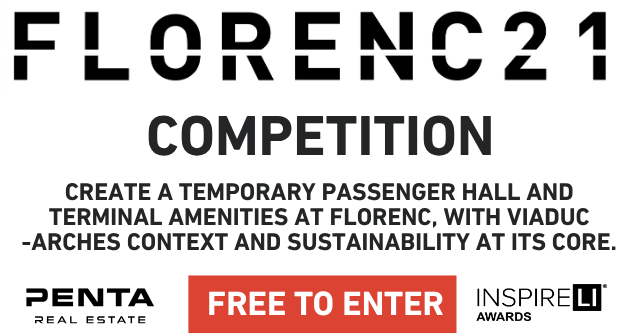Debarrierisation of Einstein Street - Multigenerational day center
Idea projektu
FILOZOFIA BREAKING DOWN BARRIERS IN BOTH SPACE AND SOCIETY Miesto projektu sa nachádza na pravom brehu Dunaja, medzi Parkom Janka Kráľa a diaľnicou D1 na Einsteinovej ulici. Toto územie disponuje zmesou protichodných vlastností a charakteristík. Diaľnica pôsobí ako mohutná urbanistická bariéra, ktorá odrezáva centrum mesta od južnej časti Bratislavy-Petržalky. Hlavnou témou projektu je "de-barierizácia" so zameraním na odstránenie fyzických bariér v území. Ku konceptu de-barierizácie sa však pristupuje na viacerých úrovniach - hmotnej aj nehmotnej. Cieľom projektu je odstrániť bariéry v oblasti okolo Einsteinovej ulice a znovu prepojiť dve časti mesta, ktoré boli necitlivo oddelené. Ku konceptu "odstraňovania bariér" sa pristupuje na dvoch úrovniach. Fyzicky dekonštruuje bariéry vytvorením zeleného parku nad diaľnicou a nehmotné bariéry medzi rôznymi sociálnymi skupinami premosťuje prostredníctvom denného multigeneračného centra. Centrum je určené pre všetky skupiny ľudí - od seniorov, detí, mladých dospelých a pracujúcich dospelých až po osoby s telesným postihnutím alebo psychickými problémami, ako je napríklad vyhorenie. Spájanie ľudí z rôznych vekových skupín a sociálnych prostredí prináša vzájomné výhody a podporuje komunitnú a sociálnu integráciu. KONCEPT MASY Architektonická forma bola formovaná myšlienkou preklenutia diaľnice a riešenia výškových zmien - eliminuje pritom schody a iné fyzické bariéry. Hmota pozostáva z pretínajúcich sa šikmých rovín, ktoré sa tiahnu ponad diaľnicu a vytvárajú sériu pochôdznych terás. Tieto terasy sú naklonené tak, aby zabezpečili nepretržité slnečné svetlo počas celého dňa a zabránili vzájomnému zatieneniu. Keďže most musí preklenúť aj železničnú trať, štruktúra parku sa rozprestiera nad traťou a nadväzuje na zelené plochy v blízkosti miestnych škôl a škôlok.
Popis projektu
RIEŠENIE PRIESTOROV Budova je rozdelená na tri typy priestorov: verejné, poloverejné a súkromné priestory. Verejné priestory sa nachádzajú na 1. a 2. nadzemnom podlaží. Na nadzemnom podlaží sú to parkovacie plochy, nabíjacie stanice pre elektromobily, pasáž, prenajímateľné priestory a stanica pre bicykle. Na 2. nadzemnom podlaží je navrhnutá sála pre podujatia mesta, ako sú diskusie, workshopy, tanečné podujatia a iné. Hlavné podlažie (3. nadzemné podlažie) je poloverejné. Je určené pre návštevníkov aj členov centra. Nachádza sa tu vstupné foyer, recepcia, kaviareň, administratíva centra, spoločenská miestnosť, športová miestnosť so šatňami a kancelária zdravotnej sestry. 4. poschodie je určené výlučne pre členov centra a ich aktivity. Patrí sem hudobná miestnosť, výtvarný ateliér, modelárska miestnosť a sála so spoločenským účelom na premietanie filmov, koncerty a medziľudskú interakciu. Na tomto poschodí sa nachádzajú aj servisné miestnosti pre členov centra, ako je kancelária psychológa a priestory na poradenstvo. Má priamy prístup do exteriéru a do záhrad. 5. najvyššie podlažie je určené na individuálnu relaxáciu s výhľadom na mesto. V južnej časti budovy, na úrovni 3. nadzemného podlažia pod svahovým parkom, sa nachádzajú verejné priestory ako bistro a galéria s priamym prístupom na pôvodný terén prostredníctvom eskalátora, výťahu alebo chodníkov pre peších a cyklistov. ARCHITEKTONICKÉ RIEŠENIE Vonkajší vzhľad budovy je definovaný nielen jej výraznou formou, ale aj riešením fasády. Budova je obalená tieniacimi žalúziami z transparentných farebných solárnych panelov, ktoré poskytujú tieň a zároveň generujú slnečnú energiu. Tieto panely sú inštalované pod uhlom, naklonené smerom od fasády, aby optimalizovali dopad slnečného svetla.
Technické informácie
KONŠTRUKČNÉ RIEŠENIE Budova sa skladá z dvoch častí - spodná časť je železobetónová konštrukcia, ktorá sa tiahne naprieč diaľnicou. Na nej je drevená konštrukcia denného centra z CLT panelov a prvkov z lepeného lamelového dreva. Okolité svahy sú tvorené zeminou, ktorá sa využíva na výsadbu nízkej aj vysokej zelene, ako aj záhrad. Niektoré priestory pod svahmi, ktoré majú nižšiu výšku stropu alebo nemajú dostatok prirodzeného svetla, sa využívajú na technické systémy (MEP) a sklady.
Alžbeta Kazičková
Faculty of Architecture and Design STU in Bratislava
Slovakia
Architektúra
Projekt odovzdaný
16. 06. 2025Štítok
Rady študentom


